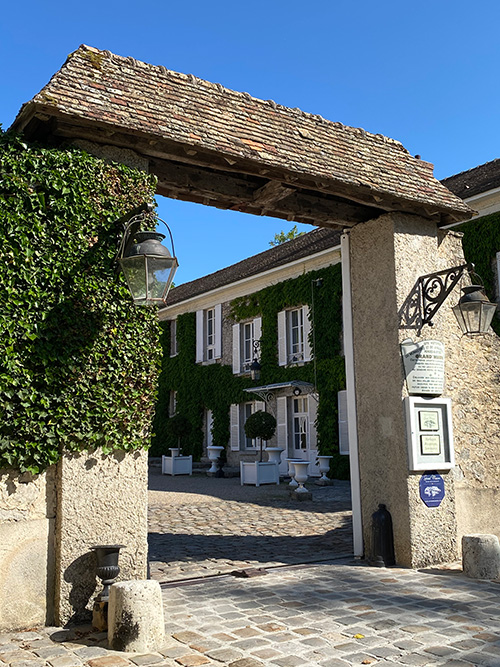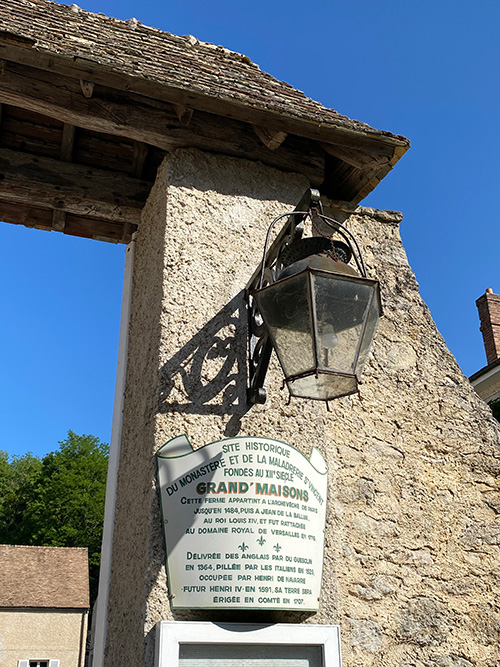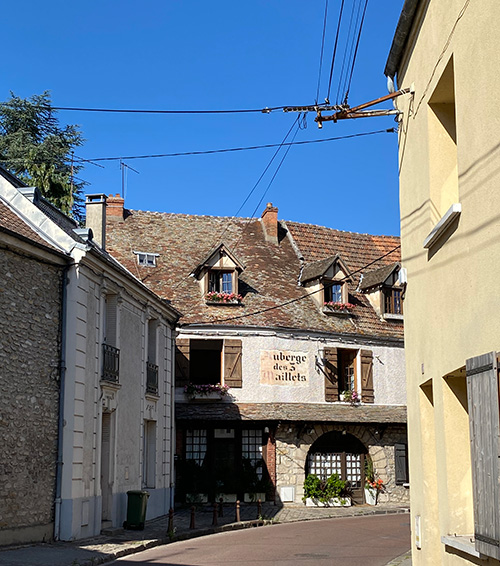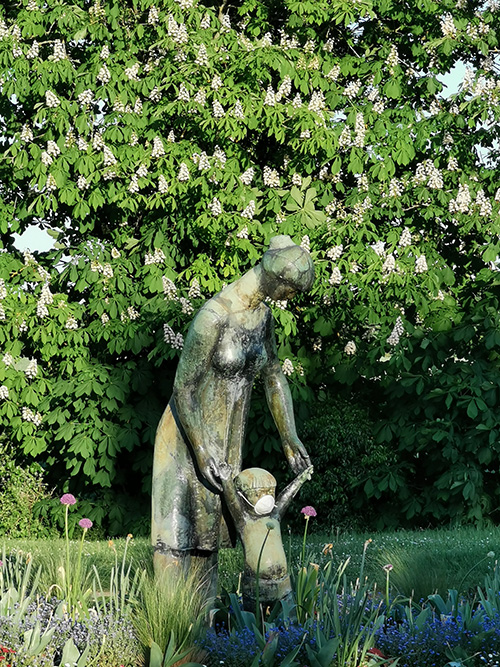During the confinement we had a lot of time to walk around our town, Villepreux, 11,000 people situated in the Yvelines department west of Paris. A usually quiet, non-descript town, we hadn’t thought too much about it before but there were a couple of spots that intrigued us while out walking within one kilometer of the house. One of them was the path that we walked called the Chemin entre Deux Murs or the path between two walls. What two walls? What was that all about? Then there’s the old village with a couple of houses that look pretty old including one with visible half timbers. There’s a chateau, in fact there are two, plus centuries-old farms and a neighborhood called the Prieuré or priory. The new center of town is a 1960s construction out of cement. Town houses and a shopping area that hasn’t worn very well over the years. The first impression is that Villepreux is a rather ordinary suburban bedroom community of Paris or closer Versailles. But once you start looking into the details, and during March, April and May 2020 we had plenty of time to visit, revisit and look things up, you realize that one town is a microcosm of much of French history.
Years before, I checked out of the library a booklet written in 1978 by a local lady on the history of Villepreux. Luckily I had scanned a copy of it because the library was closed. The booklet became one of our references. The author had even drawn an old map of the village. Another source was a booklet put out by the city a couple of years ago when they redid the paths inside the town. This booklet showed the highlights of the town: a couple sculptures and bas reliefs, the churches, the two chateaus, well springs and the schools. These two documents were the beginning of our research. We also used online sources finding architectural magazine articles and an interview with one of the sculptors.
Notable characters were Saint Vincent of Paul, a man named Nagelmackers, the Gondi family and the developer with rather utopian ideas Jacques Riboud.
The settlement goes back to Gallo Roman times at least. With two wellsprings, a small river in a valley and a wide plain it was a good place to settle. The Romans called it Villa Pirorum. The name seems to mean Villa surrounded by pear trees. Or while « Ville » likely means town « preu » might mean vaillant or stone. Like most etymologies there’s no real proof of either. The first written document with Villepreux mentioned comes from the year 836.
In the middle ages it was a thriving burg on the route between Paris and Normandy. Lots of people stayed overnight here and there were more than 25 inns at the time. More traffic was brought in by the central market. Many kings passed through here as well, including Louis XI and Henry IV. There was a market Square, pillory, goldsmith’s Street, baker’s street, a communal oven, a water mill, a church dating from before the year 1030 and a hospital. During the early Renaissance the Gondi family, originally from Florence, were the local Lords. One Lord Gondi brought in a French clergyman named Vincent of Paul to be the teacher to his children. While here, Vincent, with Mrs. Gondi’s money, built a hospital for the poor which over time became the Daughters of Charity a holy order which still exists today, not in Villepreux, but in 91 countries in the world. The life of Saint Vincent of Paul is the subject of the fresco on the 1958 church in town.
The retirement residence is called L’Orme à la Blonde which I always found odd as a name. The legend says that it refers to an elm tree that once stood on that spot. OK, great for the tree, but why « la blonde »? She was apparently the lover of king François Premier who met her there under the elm. Don’t know if it is true or not, but there’s another connection with a king for Villepreux.
The Gondi chateau, built in 1603, hosted King Henry IV. After the Gondi family the chateau was purchased by a goldsmith then a certain Henri Mackenem who was the only person from Villepreux guillotined during the revolution. Afterwards the grounds were used industrially and became a weaving center, a cashmere factory and finally was purchased by Mr. Georges Nagelmackers, a Belgian, founder and director of the Compagnie des wagons-lits, and creator or the grand European luxury trains such as the Orient Express. He removed the renaissance building and replaced it with a 19th-century château.
The arrival of the court at Versailles under Louis XIV had a huge impact on Villepreux. Large farms were established just outside of town to raise food and meat for the court. Many of these farms are still working as such (Gally, la Faisanderie, Acoigny, Grignon) on the Plain of Versailles. The wall built around the domain of Louis XIV met the 16th century wall of Villepreux. The space between the walls is now our walking path called Le Chemin Entre Deux Murs. Most of the walls are gone but a couple round towers on the corners still exist from that time. Another walking path we take frequently, l’Allée Royale de Villepreux, runs directly to the back gate of Versailles. Viewed from the air you realize it is a straight line to the Grand Canal. This path was used by Louis when he went hunting. It used to be 40 meters wide and bordered by four rows of elm trees. There’s a tiny bridge along the path crossing a tiny stream. On it there’s a plaque marking it and the Allée Royale de Villepreux as a UNESCO world heritage site – in our « back yard »!
Under Louis XIV the Francini family lived in the second chateau (now owned by the Saint-Seine family as it the nearby farm Grand’Maisons which is now a conference center and wedding venue). The Francinis designed and ran the fountains of Versailles. Villepreux was also home during this time to many of those who worked at the domain of Versailles – already a bedroom community! There were merchants, agricultural workers, land owners, a notary and even a surgeon.
The French revolution in Villepreux was a time of political upheaval of course but not too much terror. Only one person was accused of treason and guillotined. The interior of the church was dismantled and transformed into a temple of reason and meeting room. The difficulty of the time came from failed crops and not enough hands to reap what little grew. It was a time of famine and it was only under the Directoire that life was better again. A few years later after the concordat the church reopened as a religious center and the priest returned. The town was then occupied by enemy troops several times. Russians and Prussians in 1814 and again occupation and famine in 1816. This yo-yo continued throughout much of the 19th century.
1854 the train line was inaugurated and there was a great train wreck in 1910. Other industries included tanneries, rope making, printing, paper making.
In 1870 Villepreux was occupied a third time by the Prussians. Between 1914 and 1918 twenty-eight men from Villepreux died in the trenches.
In 1930 there were 15 people who owned cars in Villepreux. One was a woman.
Below is a first hand account that I’ve translated written by Simone Loth-Chateau the author of the history booklet from the library and whose family lived in the priory through the second world war.
“Our village like so many others suffered from exodus, occupation, prisoners, requisitions, hunger, cold, misery. Nearby the towns of St Cyr, Versailles, Trappes and the train line were heavily bombed. But we went on hoping for four long years for liberation, always looking forward.
After D-day, during the last great bombing which flattened St Cyr, the Germans set up in the chateau of Villepreux. They realized that our home in the priory was right next-door and requisitioned it for the officer’s mess hall. They broke a hole in the garden wall and gave us 24 hours to evacuate all of our furniture, our animals and ourselves. Several other homes in town were also requisitioned. In addition, Villepreux had to house refugees from St Cyr which was in ruins and from neighboring Les Clayes, also victims of the recent bombings. We set up wherever we could in barns, chicken coops or hallways. This lasted several weeks but there was always hope of deliverance.
There was no transportation at the time. To get to Paris you had to get to the train station in the forest at St Nom la Bretèche [7 kilometers away]. It was the only train line running. It went to Paris St Lazare. This line was swarming with Parisians who were trying to come out to the countryside to find food on the farms or to cut wood in the forest.
In Villepreux a small group of resistants were organized led by the baker. They would pick up containers of munitions and arms dropped by the English planes in the fields sometimes running out in broad daylight. A few from Villepreux went to London at the beginning of the war. The resistance in Villepreux blew up a German train at the bridge. The count of Saint-Seine rescued and hid an English soldier who had parachute landed with a broken leg. For this act the count was deported and his wife was arrested.
Villepreux was exactly on the last line of defense that the Germans had installed around Paris. Every 50 meters there were cannons posted between the Forests across the plain and around the village. Most of the fields were mined.
At the beginning of August the German officers left. They gave us back the keys to our home but suggested we did not come back because of the intense fighting that was to come. The village was invaded by a contingent of very young SS assisted by a few veterans. Leaving the village was prohibited. There was no gas, no electricity, no water. The radio therefore was silent and we had no news. We knew however that the Americans were approaching surrounding us little by little. The sound of cannons became intense at times and we were satisfied to see the German army disorganized. They grabbed every vehicle they could find from carts to cars to bicycles and took all of the radios.
Two thieves stole their way into a German supply room. The Germans retaliated coming to our homes in menacing patrols with revolvers in hand as they tried to find the thieves. The next day there was a poster at the townhall that said if the thieves were not found one-fifth of the population would be shot. The thieves had hidden amongst the trees of the square and they were finally found. We feared for the lives of the thieves but just when they would’ve been shot an order came and most Germans left hastily abandoning their prisoners. Only a few SS stayed at the priory keeping their cannons aimed at the hillsides.
During this time the Underground was able to note the exact locations of the 28 German cannons surrounding Villepreux and the baker with another man were able to bring the information to the Americans who were camped in Plaisir [10km away] providing them detailed information about the line of defense. Thanks to this knowledge the village was not destroyed during the final attack during the night of the 24th and 25th of August 1944. In 1946 the Villepreux Underground was officially recognized and lauded.
The few bits of information that we were able to receive during this time was that Paris had been liberated and that Versailles was in the hands of the Americans. But we were stuck in a pocket. That night as the sun went down a great fight of artillery erupted over the village. All the inhabitants hid in the basements for hours. The ground shook and the noise was intense. Finally it stopped suddenly and things were quiet. We heard some footsteps, some horses, some vehicles, some German voices and then it was complete silence. We peeked out and miracle the village was still standing. There were some flames from fires in the park of the Château. The pavilion where St. Vincent had stayed was burning. There were several other fires too. On the plain there were huge craters from shells but most of the guns were destroyed thanks to the precise information provided by the resistants. The Germans pulled back taking the last few cannons and horses but abandoning much of everything else. But our historic village was saved!”









